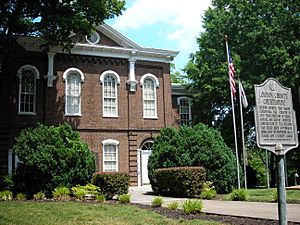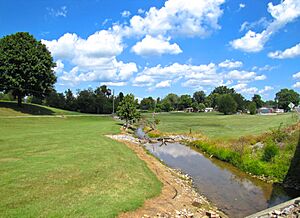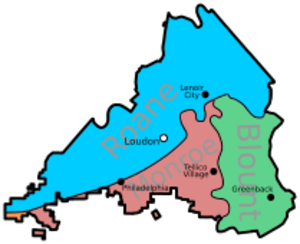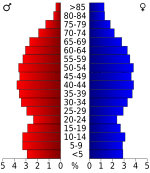Loudon County, Tennessee facts for kids
Quick facts for kids
Loudon County
|
|
|---|---|

The Loudon County Courthouse in Loudon
|
|

Location within the U.S. state of Tennessee
|
|
 Tennessee's location within the U.S. |
|
| Country | |
| State | |
| Founded | 1870 |
| Named for | Fort Loudoun |
| Seat | Loudon |
| Largest city | Lenoir City (population) Loudon (area) |
| Area | |
| • Total | 247 sq mi (640 km2) |
| • Land | 229 sq mi (590 km2) |
| • Water | 18 sq mi (50 km2) 7.3%% |
| Population
(2020)
|
|
| • Total | 54,886 |
| • Estimate
(2023)
|
60,591 |
| • Density | 222.2/sq mi (85.80/km2) |
| Time zone | UTC−5 (Eastern) |
| • Summer (DST) | UTC−4 (EDT) |
| Congressional district | 2nd |
Loudon County is a county in the state of Tennessee, USA. It is located in the central part of East Tennessee. In 2020, about 54,886 people lived there. The main town and county seat (where the county government is) is Loudon. Loudon County is part of the larger Knoxville area.
Contents
History of Loudon County
Loudon County was created on May 27, 1870. It was formed from parts of three nearby counties: Roane, Monroe, and Blount.
At first, it was called Christiana County. But a few days later, its name was changed to Loudon. This was to honor Fort Loudoun, a fort built a long time ago. The fort itself was named after John Campbell, 4th Earl of Loudoun. He was a British commander during the French and Indian Wars.
In August 1870, the first county leaders were chosen. The county court started meeting on September 5, 1870. They met in the Baptist Church in Loudon. This church was used until a new courthouse was finished in 1872.
Bussell Island is an important historical site. It is located where the Little Tennessee River meets another river. Native Americans lived on this island for thousands of years. The Overhill Cherokee village of Mialoquo was also nearby.
The British built Fort Loudoun in 1756. It was near where Vonore is today. The Cherokee people destroyed the fort four years later.
One of the first American settlements in Loudon County was Morganton. It was a river port and ferry stop. Morganton was busy in the early 1800s. However, it became less important when railroads started to grow. The remains of the town were covered by Tellico Lake in the 1970s.
Lenoir City started as a large farm owned by William Ballard Lenoir in 1810. By the 1850s, it had a train stop called Lenoir Station. In the 1890s, a company planned out the modern Lenoir City.
The town of Loudon began as a ferry and steamboat stop. It was started by James Blair in the 1810s. The town changed its name to "Loudon" in the 1850s. This happened when the railroad arrived and the town grew.
During the American Civil War, in November 1861, some Union fighters tried to destroy the railroad bridge at Loudon. This was part of a plan to burn bridges in East Tennessee. But the bridge was too well-guarded by Confederate soldiers. So, the fighters gave up.
Geography and Natural Features

Loudon County covers about 247 square miles. Most of this is land (229 square miles). The rest is water (18 square miles), which is about 7.3% of the total area.
The Little Tennessee River flows into the Tennessee River near Lenoir City. The lower part of the Little Tennessee River is now part of Tellico Lake. This lake was made by the Tellico Dam.
The Fort Loudoun Dam is on the Tennessee River. It creates Fort Loudoun Lake. The river section below Fort Loudoun Dam is part of Watts Bar Lake.
Counties Nearby
- Knox County (northeast)
- Blount County (east)
- Monroe County (south)
- McMinn County (southwest)
- Roane County (northwest)
Protected Natural Areas
- Tellico Lake Wildlife Management Area (part of it is in Loudon County)
Population and People
| Historical population | |||
|---|---|---|---|
| Census | Pop. | %± | |
| 1880 | 9,148 | — | |
| 1890 | 9,273 | 1.4% | |
| 1900 | 10,838 | 16.9% | |
| 1910 | 13,612 | 25.6% | |
| 1920 | 16,275 | 19.6% | |
| 1930 | 17,805 | 9.4% | |
| 1940 | 19,838 | 11.4% | |
| 1950 | 23,182 | 16.9% | |
| 1960 | 23,757 | 2.5% | |
| 1970 | 24,266 | 2.1% | |
| 1980 | 28,553 | 17.7% | |
| 1990 | 31,255 | 9.5% | |
| 2000 | 39,086 | 25.1% | |
| 2010 | 48,556 | 24.2% | |
| 2020 | 54,886 | 13.0% | |
| 2023 (est.) | 60,591 | 24.8% | |
| U.S. Decennial Census 1790-1960 1900-1990 1990-2000 2010-2014 |
|||
The population of Loudon County has grown steadily over the years. In 2020, there were 54,886 people living here. About 30,449 of these people were born in Tennessee.
Most people in Loudon County are White (about 84.57%). There are also people who identify as Black or African American (1.05%), Asian (0.82%), and Native American (0.17%). About 9.76% of the population is Hispanic or Latino.
In 2010, the average household had about 2.42 people. The average family had about 2.82 people. About 20.32% of the population was under 18 years old. About 21.49% were 65 years or older. The median age was 46.0 years.
The median household income in 2010 was $49,343. This means half of the households earned more, and half earned less. About 13.8% of the population lived below the poverty line. This included 23.8% of children under 18.
Education in Loudon County
Loudon County has several public schools. Most of them are run by Loudon County Schools. Lenoir City has its own separate school system.
Loudon County Schools
- Loudon High School
- Greenback School (serves students from kindergarten to 12th grade)
- Fort Loudoun Middle School
- North Middle School
- Eaton Elementary School
- Highland Park Elementary School
- Loudon Elementary School
- Philadelphia Elementary School
- Steekee Elementary School
- Loudon County Technology Center
Lenoir City Schools
- Lenoir City High School
- Lenoir City Intermediate/Middle School
- Lenoir City Elementary School
Towns and Communities
Loudon County has several cities, towns, and other communities.
Cities
Towns
- Farragut (part of this town is in Loudon County)
Census-designated places
These are areas that are like towns but are not officially incorporated.
- Rarity Bay (partly in Monroe County)
- Tellico Village
Unincorporated communities
These are smaller communities that are not part of any city or town.
See also
 In Spanish: Condado de Loudon para niños
In Spanish: Condado de Loudon para niños



